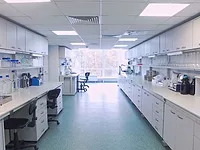Painting-Back to the Basics
What to write in a paint column? HHHmmmmm.... It seems that whatever can be written already has been.
I wonder what the first application of color was. Could it have been charred wood on a rock? Whatever it was, there probably was not too much concern over the consistency of color value, or the depth, flow and travel of the paint. Exotic pigments, additives, solvents, durability and gloss were not issues as they are today.
There have been literally thousands of improvements in paints and application techniques throughout the years. Yet, in all painting, there is one consistent problem that will not go away. It has haunted us from the start. We scrape it, flush it, identify it, sand it and blow it with air. We have stood and stared at it seemingly for hours on end as if, by looking, it would disappear before our eyes.
Some have hired others and spent millions of dollars to make it go away, yet it returns like a teenager after leaving for college-usually not alone and requiring great amounts of money and attention.
I have heard of some that have sent it to labs and universities to identify it. Others have grown their own in-house expertise to deal with the problem. Some have tried to nuke it, wet it, de-static it and even have it sink into the paint itself.... IT STILL PERSISTS.
Of course by now you know I'm talking about our nemesis, Mr. Dirt, or as we more sophisticated paint folks like to call it, "foreign material." A lot of people like this phrase because it covers such a wide range of interpretation, and nobody is really accountable.
This material could be weld balls from the welding shop, specs of mica from the paint, smeared sealer, fibers, craters from deodorants or hand creams, or just airborne dust. But when someone says "foreign material," it adds more mystique to our business.
Preventing dirt is like the blocking and tackling in football: It's not very glamorous but absolutely necessary to ensure success. And it's not all that mysterious; it's about the basics. And the basics do not mean waiting for the dirt, identifying it and then preventing it. Prevention is worth more than a pound of cure; it's worth big savings in quality and dollars.
The same basics apply today as they did many years ago. The product must be immaculate when it enters the paint shop. It must be free of metal-grinding dust, weld balls, excess sealer, dents and dings and other miscellaneous debris. We then turn it into a work of art. Transform it into a colored jewel to be trimmed and sent along to the customer.
Quality gates must be established at each critical step during the journey through paint. This is accomplished with discipline throughout the painting process. Discipline, in the sense that each operator knows what his or her part is and executes it with precision each and every time. Easier said than done, right?
Management must be committed to the process and show it every day. All employees need to understand their roles and how they affect the final product. Whether they are painting automobiles, airplanes or appliances, each employee's operation has a dramatic affect on the final appearance. If people understand the importance of their roles, they have an opportunity to contribute.
Preventive maintenance is one of the keys to reducing dirt in paint. Setting up and following schedules for filter changes and spray equipment cleaning and dress codes requires discipline.
Developing, following and refining the process is a proven roadmap to success, but it will not be accomplished without the stamina to repeat the effort day after day after day.
Any reduction of nonpainting processes in the paint facility will certainly help reduce the opportunity for dirt. Paint shops must be hospital clean, and the attention paid to detailed preventive maintenance and cleaning must be ongoing.
Process control and doing the same correct things time after time is the key to success.
Looking for a reprint of this article?
From high-res PDFs to custom plaques, order your copy today!





